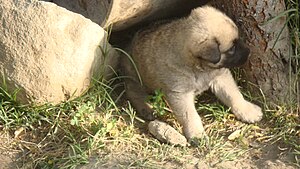 |
| English: Puppy in the Garden (Photo credit: Wikipedia) |
You may want an indoor puppy, but he is making it almost
impossible. If you have problems with inappropriate chewing and ineffective
potty training, you must work at training your puppy correctly. The below
article provides excellent advice on proper puppy training methods so that your
puppy can peacefully live in your home.
Use consistency when you are crate training your young
puppy. Give the puppy consistent opportunities to relieve him every time you
let him out. As he gets older, he will gain greater control of his bodily
functions, making it easier to control himself.
Begin training your puppy with a task that will be simple
for him to learn. This will give them instant success and serve as a building
block for your training regimen. You'll have better results this way.
Puppies who are allowed to go to the bathroom indoors must
have a specific area in which to go. Put potty pads in the area, and then
slowly move them so that eventually, there is just one pad situated in the spot
where you want the puppy to relieve itself.
When training your pet, you must be patient. This will make
it less likely that you or your puppy will become frustrated or upset with the
process of training. Your puppy's goal is to make you happy, but since he does
not speak like a human does, it is harder for him to communicate.
When you are using a puppy crate in your training, you need
to help your puppy get used to it as his home. Whenever it's time for them to
eat, place their food bowl into the crate and leave the door open when eating.
This will create a good association between the crate and their food.
It is important to have flexible methods of training when
teaching your puppy. There will be times when your puppy finds it difficult to
learn the desired behavior and flexibility will allow you to experiment with
different methods. You'll then be able to tweak your techniques to fit your puppy
and situation, so you'll have a better chance of success.
Always use positive reinforcement to train your puppy. Sweet
treats or gentle petting is great rewards when the puppy is behaving properly.
You should not hit or yell at your puppy. This teaches your puppy nothing and
will just show him that you do not know how to train him. If you want good
results, you must be positive, consistent and firm as you train your puppy.
Don't give mixed signals. If you laugh or smile at cute but
bad behavior, he will be more likely to continue it. If you do, training will
be damaged. Your puppy's misbehavior may be funny on a certain level, but don't
let him know you think so.
Anytime your puppy does something good, make sure you reward
him. It is important for the puppy to realize when he exhibits the proper
behavior in response to your commands. You need to do this because your puppy
must know what they can and cannot do.
Reinforce positive behaviors. Don't punish him all the time,
but give treats for good behavior. Enforcing negatively may cause your puppy to
fear you. Reinforcing good behaviors will cause the puppy to work harder to
please you and receive praise.
A good tip is to make sure you are aware if other puppies
are present when you are walking your puppy. You need to be well aware of any puppies
that seem aggressive. If you see a puppy acting aggressively or fearfully,
avoid that puppy.
When training a puppy, start with giving them a treat each
time they accomplish what you ask. Over time, you can adjust your approach to
reward the behaviors with a treat only three-fourths of the time. This
frequency can be decreased as you progress through training sessions.
"Down" is an important command for puppies to
learn. This command will be useful if you need to keep your puppy from jumping
on someone. A puppy that is well trained to drop on command is a much safer
pooch.
If you're traveling with puppies, remember to have
everything that your pet may need in terms of sleeping as well as when it comes
to using the bathroom. Items such as food and water dishes are essential when
traveling. You do not have to bring some food for your puppy with you because
you can easily find quality food anywhere you go.
To train a puppy to have good manners, training must be
deliberate and consistent Perfection doesn't come overnight. Without constant
practice, nothing is worthwhile in life. The same applies when puppy training.
Whether your pet is destined for indoors or outdoors,
training him can be quite challenging. You are losing your patience and losing
good furniture. Use the tips from this article to make puppy training easy.




